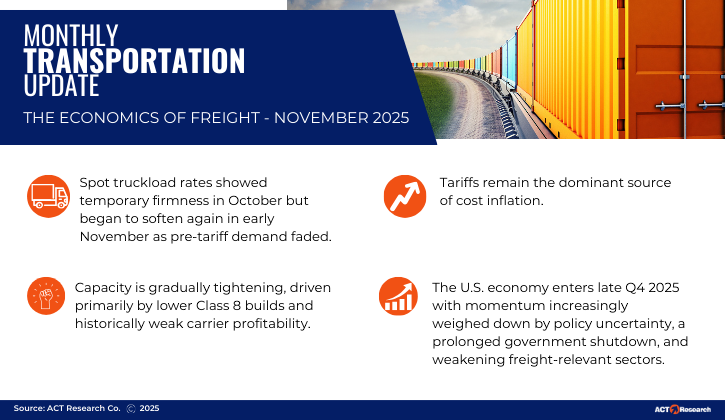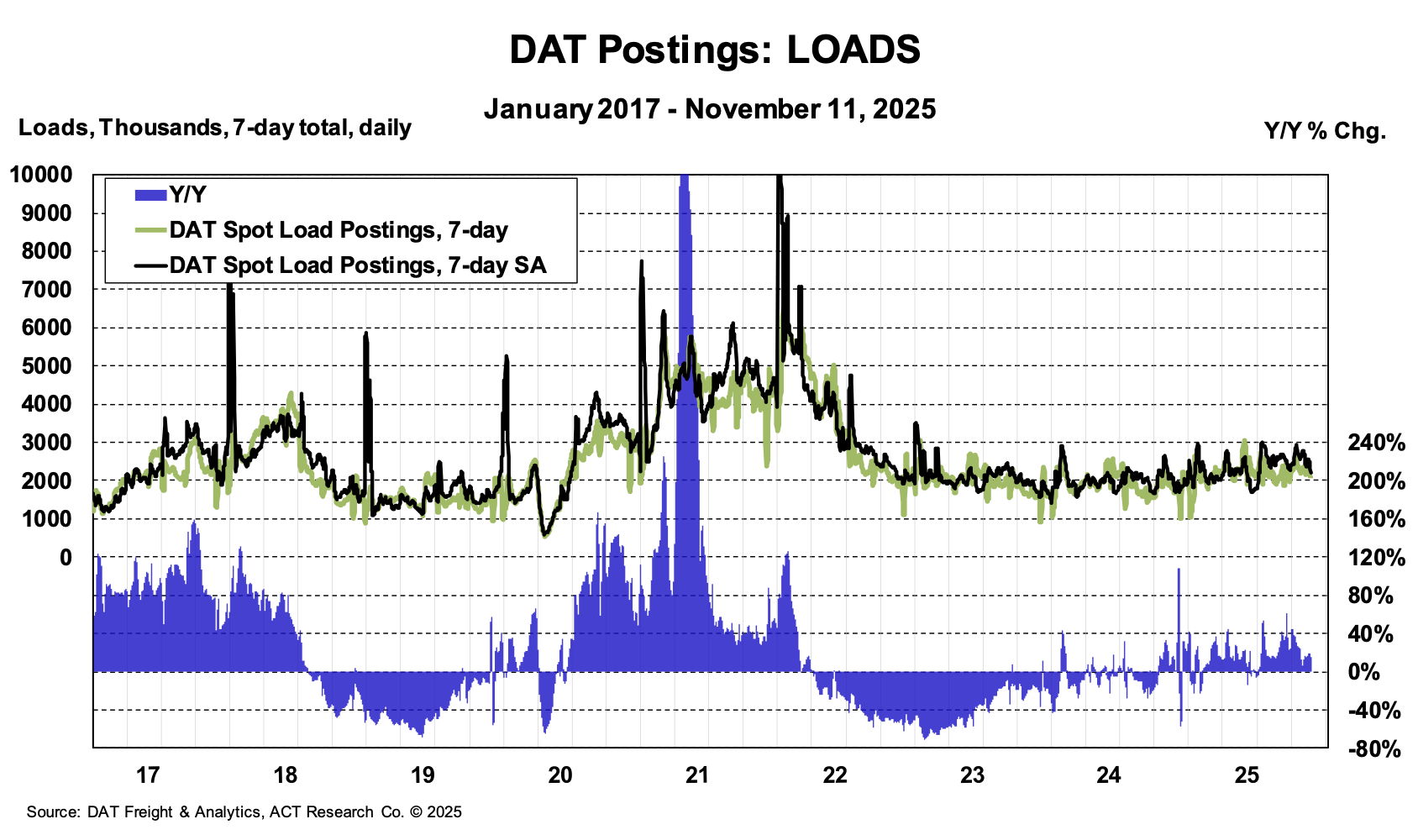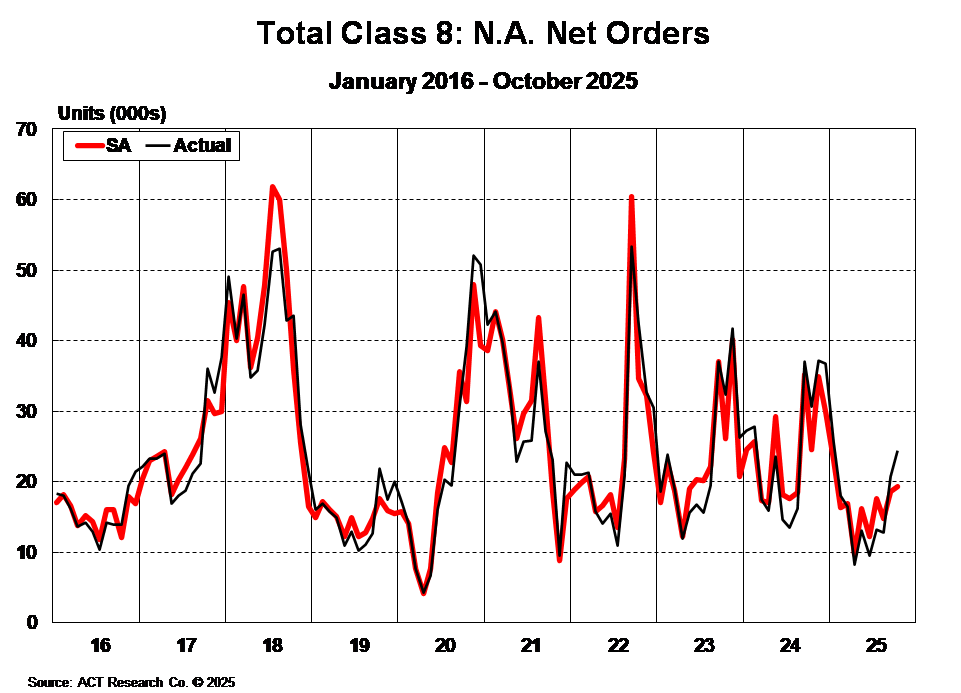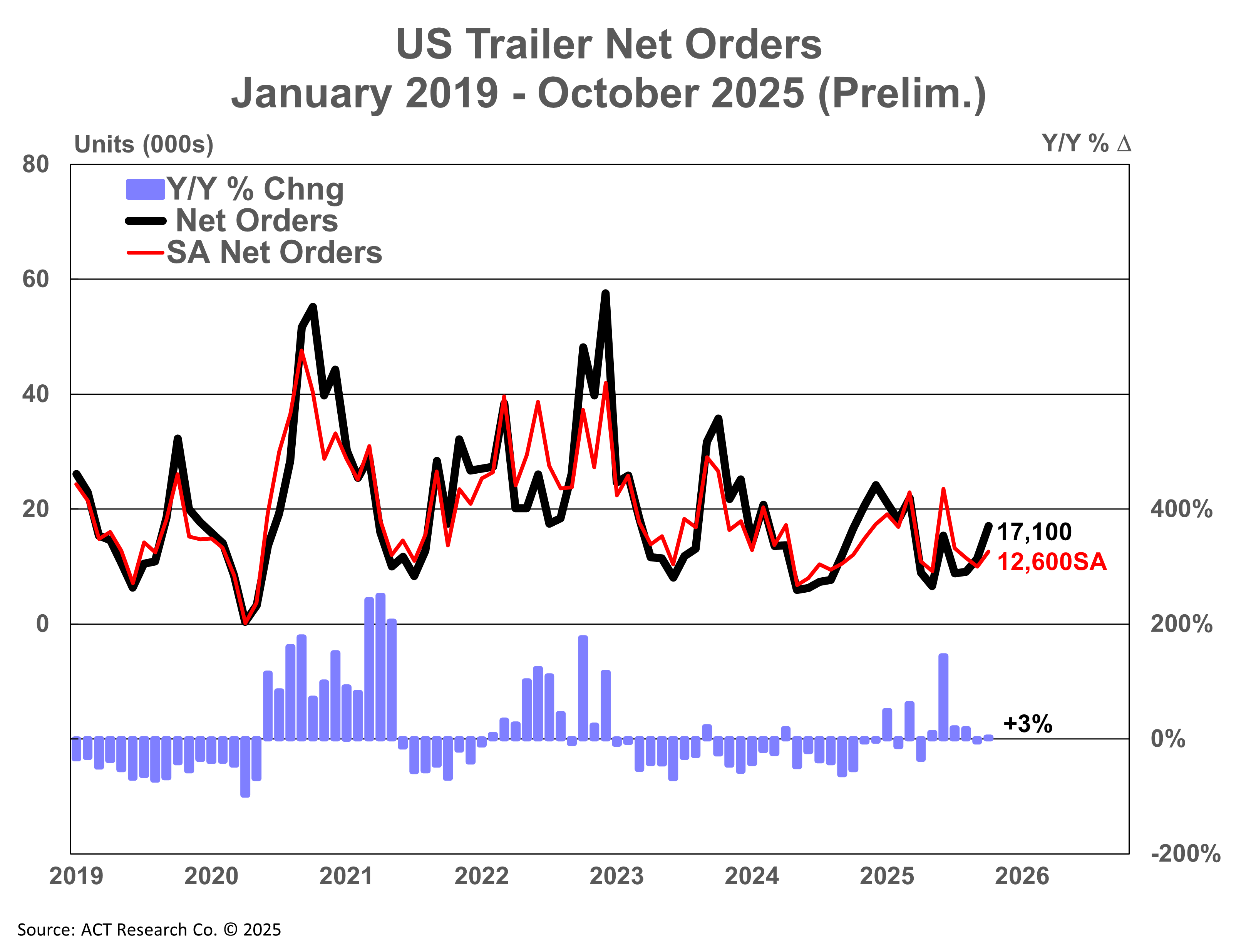
The U.S. trucking industry has moved beyond the sharp contraction phase of 2023 and into an extended correction cycle as of September 2025. While capacity is beginning to tighten gradually, freight volumes remain soft and tariff-driven cost pressures continue to weigh on margins, keeping the pace of rebalancing slow and uneven.
Looking ahead to 2026, the North American trucking industry faces a highly uncertain environment shaped by trade policy outcomes, regulatory clarity on EPA 2027 emissions standards, and the trajectory of consumer demand. Key factors such as freight recovery timing, Class 8 production trends, and macroeconomic policy shifts will determine whether the industry stabilizes or remains mired in a prolonged low-growth phase.

How confident should your business be in ACT's forecasting for 2025?
For 2023, ACT's forecasts for the shipments component of the Cass Freight Index® were 96.9% accurate on average for the 24-month forecast period.
ACT Research’s 2023 forecasts for the Cass Truckload Linehaul Index® were 96.6% accurate on average over the past 24 months, and 98.5% accurate over the past 12 months.
Trucking Industry Outlook
November 2025
Updated November 21, 2025
Economic Overview
The U.S. economy enters late Q4 2025 with momentum increasingly weighed down by policy uncertainty, a prolonged government shutdown, and weakening freight-relevant sectors. While headline GDP remains positive, the Congressional Budget Office estimates that the shutdown has already reduced Q4 growth by roughly a full percentage point on an annualized basis. Inflation remains elevated around the mid-3% range as tariff-driven goods inflation accelerates into 2026.
Freight-intensive segments—including manufacturing, housing, and goods-oriented retail—continue to underperform broader economic activity. Recent trade war escalations have further dampened imports and industrial production, with early Q4 showing clear payback effects from the pre-tariff pull-forward that drove volumes in mid-2025.
The §232 heavy-vehicle tariffs, now fully applied to foreign content, are adding thousands of dollars per Class 8 unit and weighing heavily on both freight and equipment markets. A pending Supreme Court decision on IEEPA tariffs could provide partial relief if overturned, though §232 and §301 tariffs remain outside the case and will continue to pressure equipment costs regardless of the ruling.
The Federal Reserve has held rates steady, but a softening labor market—reflected in rising layoffs and slowing wage gains—suggests the next move is likely a cut. Payroll expansion has slowed meaningfully, and job market indicators point to cooling heading into 2026.
Transportation Sector and Freight Trends
Freight Demand Moderation
Freight volumes weakened further through October as pre-tariff tightness unwound. DAT load posts remained up y/y but declined m/m as capacity returned to the market. Industrial, consumer, and cross-border flows all softened, with the National Retail Federation now expecting holiday spending to contract in real terms. This implies another decline in goods-oriented freight through Q4.
Private fleets continue gaining share, helped by superior routing control and improved service stability. With for-hire carriers posting recession-like margins again in Q3, competitive pressure remains intense, particularly in dry van and general merchandise freight.

Capacity Rebalancing in Progress
Capacity is gradually tightening, driven primarily by lower Class 8 builds and historically weak carrier profitability. Tractor inventories continue to normalize as OEMs maintain disciplined build schedules, while vocational inventories remain elevated and are correcting more slowly.
Used truck activity held steady in October, but pricing softened for the third consecutive month. Dealer retail prices declined again, and auction and wholesale values also fell as payback from pre-tariff freight continues to depress demand. Although capacity is contracting, supply still exceeds freight needs—keeping the market in an extended period of imbalance.
Spot Rate Volatility
Spot truckload rates showed temporary firmness in October but began to soften again in early November as pre-tariff demand faded. The DAT load-to-truck ratio fell back from October highs but remains above the first-half average due to tightened supply.
Spot rates are expected to remain under pressure into early 2026 as freight volumes recede from pre-tariff peaks, though tighter capacity should help limit further declines. Rate recovery is increasingly tied to the outcome of the Supreme Court tariff case and the pace of fleet contraction into mid-2026.

Class 8 Trucks
Class 8 demand remains weak. October orders were well below seasonal norms, extending the year’s soft trend. Order activity failed to materialize even as the typical peak order season opened, reflecting ongoing pressure on for-hire margins and uncertainty around tariffs and EPA 2027.
OEMs continue to maintain conservative build schedules. Backlogs increased as builds declined, and the backlog-to-build ratio remained elevated. Inventories continued trending lower, particularly in tractors, but remain high in vocational categories. With 2026 set to bring higher equipment costs and carriers still underwater financially, ordering activity remains centered on basic replacement needs.

Medium-Duty Vehicles (Classes 5–7)
Medium-duty activity remained soft in October. Net orders improved sequentially but remain well below historical norms as slowing services growth, cautious consumers, and weaker construction activity weigh on demand. Inventories remain elevated, with OEMs trimming production and body-builder delays continuing to limit throughput.
Sales softened, and the inventory-to-retail-sales ratio rose, signaling ongoing imbalance in the MD market heading into 2026.
Trailers
The trailer market showed an uptick in October orders but remains fundamentally soft. Net orders increased from September but stayed below healthy cycle levels. Backlogs continued to shrink, reaching historically low levels entering Q4.
Trailer build rates rose slightly on higher production days, but OEMs continue to manage output conservatively. Dry vans and reefers remain weak relative to long-term norms, while flatbeds performed better on easier comparisons. The overall BL/BU ratio remains well below historical averages, with orderboards for 2026 still described by OEMs as “subpar but not dire.”

Regulatory and Market Drivers
Tariffs & Cost Inflation
Tariffs remain the dominant source of cost inflation. The 232 heavy-vehicle tariffs continue to inflate equipment prices significantly, particularly for Mexico-sourced units. Additional tariff actions—such as increased duties on Canadian imports—are adding further uncertainty. With logistics, insurance, and borrowing costs also elevated, fleet capital budgets remain under heavy pressure.
EPA 2027 Compliance
EPA 2027 remains the largest unresolved regulatory issue. With only months remaining and no guidance issued, expectations are shifting toward partial implementation focused on technology requirements, with warranty and useful-life extensions likely to be delayed or revised. Regulatory ambiguity continues to suppress prebuy activity and keeps fleets in a defensive capital posture.
Labor Dynamics
Driver availability remained balanced in October. Softer freight volumes have reduced hiring urgency, though demographic constraints remain a long-term concern. Private fleet pay is materially higher than for-hire, helping attract labor and contributing to ongoing share shifts. Fleets continue focusing on retention, technology-assisted routing, and safety improvements to manage labor costs amid muted productivity gains.

Stay Ahead with Smarter Freight Insights
Success in trucking and freight comes from knowing what’s next—not just what’s now. At ACT Research, we deliver forward-looking market intelligence that helps you anticipate shifts, prepare for cycles, and stay strategically positioned. As your trusted transportation intelligence partner, we give you the tools to act with confidence—so you can optimize operations, reduce risk, and drive stronger profitability.